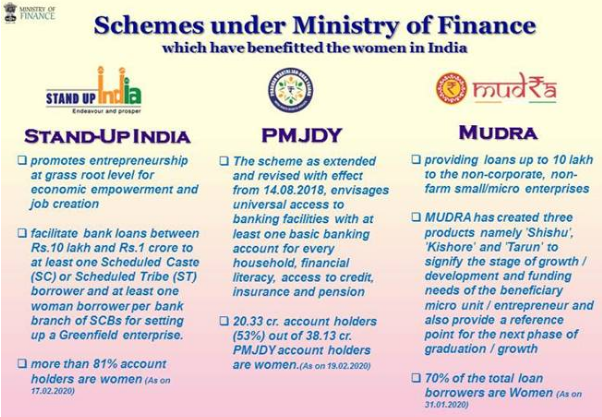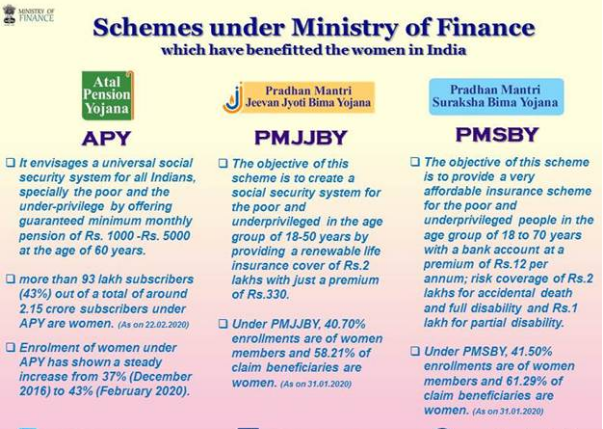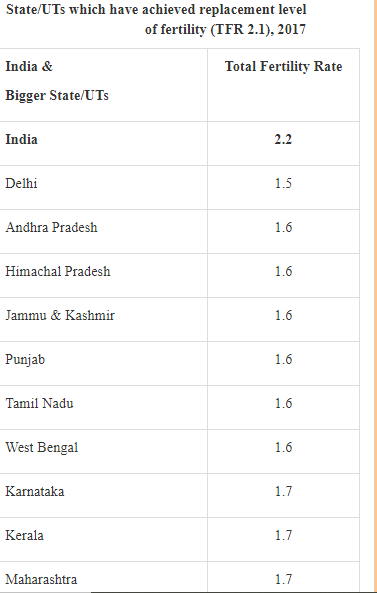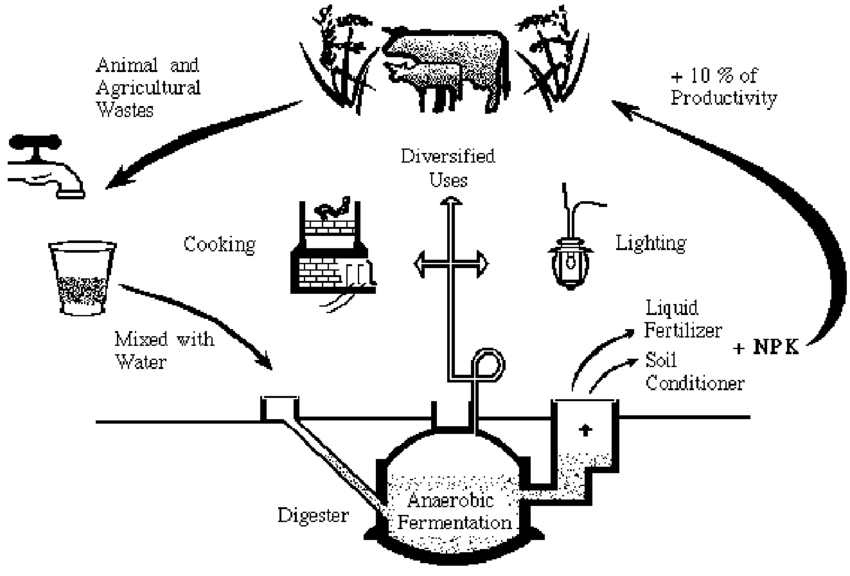Contents:
- Crop Diversification
- Cultivation of GM Crops
- Doubling Farmers’ Income
- Women Empowerment Schemes Under Ministry of Finance
- Trans Fat
- Re-introduction of COPTA bill
- States Successful in Achieving Control on Population Growth
- Biomethanation To tackle stubble burning
CROP DIVERSIFICATION
Focus: GS-III Agriculture, Economic Development, Prelims
Why in news?
Department of Agriculture, Cooperation & Farmers Welfare (DAC&FW) is implementing a Crop Diversification Programme (CDP) for replacing paddy crop with less water consuming alternative crops to save water and protect soil in the state of Punjab.
What is Crop Diversification Programme?
Crop Diversification Programme (CDP), a sub scheme of Rashtriya Krishi Vikas Yojana (RKVY) is being implemented in Original Green Revolution States to divert the area of paddy crop to alternate crops and in tobacco growing states to encourage tobacco farmers to shift to alternate crops/cropping system.
Rashtriya Krishi Vikas Yojana (RKVY)
Rashtriya Krishi Vikas Yojana is a special Additional Central Assistance Scheme which was launched in August 2007 to orient agricultural development strategies, to reaffirm its commitment to achieve 4 per cent annual growth in the agricultural sector during the 11th plan. The scheme was launched to incentivize the States to provide additional resources in their State Plans over and above their baseline expenditure to bridge capital gaps.
CULTIVATION OF GM CROPS
Focus: GS-III Science and Technology, Prelims
Why in news?
Area, production and productivity of Bt. cotton has increased steadily since its introduction in India, barring minor fluctuation in few years
Details
Most of the countries are signatory to the Cartagena Protocol on Bio-safety which has well defined mechanism of regulation of Genetically Modified (GM) crops including bio-safety evaluation and environmental release.
Bt. cotton is the only GM crop approved by the Genetic Engineering Appraisal Committee (GEAC) which works under MOEFC.
What are GM Crops?
- Genetically modified crops (GM crops) are plants used in agriculture, the DNA of which has been modified using genetic engineering techniques. More than 10% of the world’s crop lands are planted with GM crops.
- In most cases, the aim is to introduce a new trait to the plant which does not occur naturally in the species like resistance to certain pests, diseases, environmental conditions, herbicides etc.
- Genetic Modification is also done to increase nutritional value, bioremediation and for other purposes like production of pharmaceutical agents, biofuels etc.
Regulating Bodies concerned with GM Crops
GEAC
The top biotech regulator in India is Genetic Engineering Appraisal Committee (GEAC).
The committee functions as a statutory body under the Environment Protection Act 1986 of the Ministry of Environment & Forests (MoEF).
GEAC is responsible for granting permits to conduct experimental and large-scale open field trials and also grant approval for commercial release of biotech crops.
The Rules of 1989 also define five competent authorities i.e.,
- The Institutional Biosafety Committees (IBSC),
- Review Committee of Genetic Manipulation (RCGM),
- Genetic Engineering Approval Committee (GEAC),
- State Biotechnology Coordination Committee (SBCC) and
- District Level Committee (DLC)
for handling of various aspects of the rules.
Cartagena Protocol
- The Cartagena Protocol on Biosafety to the Convention on Biological Diversity is an international agreement on biosafety as a supplement to the Convention on Biological Diversity effective since 2003.
- The Biosafety Protocol seeks to protect biological diversityfrom the potential risks posed by genetically modified organisms resulting from modern biotechnology.
DOUBLING FARMERS INCOME
Focus: GS-III Economic Development, Agriculture, Social Justice, Prelims
Why in news?
The National Sample Survey Office (NSSO) report for 2013-14, farmers’ average monthly income stood at Rs. 6,426.
At present as per the last survey available for 2016-17, it stands at Rs. 8,167.
India’s plan to Increase Farmers’ Income
- National Commission for Farmers was constituted in 2004, chaired by Prof. M. S. Swaminathan, to suggest methods for faster and more inclusive growth for farmers.
- Then, the Government of India in 2016 constituted an expert committee headed by Ashok Dalwai to look into the entire agriculture ecosystem in the country to suggest ways and means to reform it so that farmers’ income can be doubled by 2022.
- The Committee submitted its final report to the Government in September 2018.
Steps taken by the Indian Government
Institutional Reforms
- Pradhan Mantri Krishi Sinchai Yojana,
- Soil health card
- Prampragat Krishi Vikas Yojana
- Pradhan Mantri Fasal Bima Yojana– Provide insurance against crop and income loss and to encourage investment in farming.
- Interlinking of rivers (ILP) – To reduce dependence on Monsoon and Increase Crop Production
- ‘Operation Greens’– To address price volatility of perishable commodities like Tomato, Onion and Potato (TOP).
- PM Kisan Sampada Yojana– To promote food processing in a holistic manner.
Technological Reforms
- eNAM– A pan-India electronic trading portal.
- Technology mission on cotton which aims to increase the income of the cotton growers by reducing the cost of cultivation as well as by increasing the yield per hectare through proper transfer of technology to the growers.
- Technology Mission on Oilseeds, Pulses and Maize (TMOPM)
- Mission for Integrated Development of Horticulture (MIDH)- a scheme for the holistic growth of the horticulture sector.
- Sugar Technology Mission
- National Mission on Sustainable Agriculture– aims at promoting sustainable agriculture through a series of adaptation measures.
- In addition, schemes relating to tree plantation (Har Medh Par Ped), Bee Keeping, Dairy and Fisheries are also implemented.
WOMEN EMPOWERMENT SCHEMES UNDER MINISTRY OF FINANCE
Focus: GS-II Social Justice, Prelims
Stand Up India Scheme –
- Stand Up India Scheme was launched on 5 April 2016 to promote entrepreneurship at grass root level
- scheme seeks to leverage the institutional credit structure to reach out to the underserved sector of people such as Scheduled Caste, Scheduled Tribe and Women Entrepreneurs
- The objective of this scheme is to facilitate bank loans between Rs.10 lakh and Rs.1 crore to at least one Scheduled Caste (SC) or Scheduled Tribe (ST) borrower and at least one woman borrower per bank branch of SCBs for setting up a Greenfield enterprise.
- More than 81% account holders are Women under Stand up india scheme
Mudra- Micro Units Development & Refinance Agency
- PMMY was launched on April 8, 2015 for providing loans up to 10 lakh to the non-corporate, non-farm small/micro enterprises. These loans are classified as MUDRA loans under PMMY. These loans are given by Commercial Banks, RRBs, Small Finance Banks, MFIs and NBFCs
- Under the aegis of PMMY, MUDRA has created three products namely ‘Shishu’, ‘Kishore’ and ‘Tarun’
- 70% of the total loan borrowers are Women
PMJDY – Pradhan Mantri Jan-Dhan Yojana
PMJDY envisages universal access to banking facilities with at least one basic banking account for every adult, financial literacy, access to credit, insurance and pension
APY- Atal Pension Yojana
- Envisages a universal social security system for all Indians, specially the poor and the under-privilege by offering guaranteed minimum monthly pension of Rs. 1000 -Rs. 5000 at the age of 60 years.
- More than 93 lakh women subscribers (43%) out of a total of around 2.15 crore subscribers
PMJJBY – PM Jeevan Jyoti Bima Yojana
- Social security system for the poor and underprivileged in the age group of 18-50 years by providing a renewable life insurance cover of Rs.2 lakhs with just a premium of Rs.330.
- Under PMJJBY, 40.70% enrollments are of women members and 58.21% of claim beneficiaries are women.
PMSBY – Pradhan Mantri Suraksha Bima Yojana
- PMSBY was launched on 9th May 2015. The objective of this scheme is to provide a very affordable insurance scheme for the poor and underprivileged people in the age group of 18 to 70 years with a bank account at a premium of Rs.12 per annum; risk coverage of Rs.2 lakhs for accidental death and full disability and Rs.1 lakh for partial disability.
- Under PMSBY, 41.50% enrollments are of women members and 61.29% of claim beneficiaries are women. (As on 31.01.2020)


TRANS FAT
Focus: GS-III Science and Technology, Prelims
Why in news?
- The limit of trans-fats to be not more than 5% is prescribed under Food Safety and Standards (Food Products Standards and Food Additives) Regulations, 2011 for vanaspati, bakery shortenings, bakery and industrial margarine and interesterified vegetable fats/oils.
- A draft notification to limit trans-fat to be not more than 2% by weight of the total oils/fats present in the processed food products was issued on 28.08.2019.
Trans fat
- Trans fat, also called trans-unsaturated fatty acids or trans fatty acids, is a type of unsaturated fat that occurs in small amounts in meat and milk fat.
- Although trans fats are edible, consuming trans fats has been shown to increase the risk of coronary artery disease in part by raising levels of low-density lipoprotein (LDL, often termed “bad cholesterol”).
Food Safety and Standards Authority of India (FSSAI)
- FSSAI is an autonomous body established under the Ministry of Health & Family Welfare, Government of India.
- The FSSAI has been established under the Food Safety and Standards Act, 2006 which is a consolidating statute related to food safety and regulation in India.
- Hence, FSSAI is a Statutory Body
- FSSAI is responsible for protecting and promoting public health through the regulation and supervision of food safety.
The main aim of FSSAI is to
- Lay down science-based standards for articles of food
- To regulate manufacture, storage, distribution, import and sale of food
- To facilitate safety of food
Standards framed by FSSAI are prescribed under:
- Food Safety and Standards (Food Product Standards and Food Additives) Regulation, 2011,
- Food Safety and Standards (Packaging and Labelling) Regulation, 2011
- Food Safety and Standards (Contaminants, Toxins, and Residues) Regulations, 2011.
RE-INTRODUCTION OF COTPA BILL
Focus: GS-II Social Justice, Governance
Addressing Tobacco, Alcohol and Substance Abuse
- The target envisaged in National Health Policy, 2017 for relative reduction in prevalence of current tobacco use is 30% by 2025.
- The National Health Policy 2017 of the Government of India identifies coordinated action on ‘Addressing tobacco, alcohol and substance abuse’ as one of the seven priority areas as outlined for improving the environment for health.
- Accordingly, Nasha Mukti Abhiyan Task Force (including tobacco, alcohol and substance abuse) was constituted with to formulate a detailed ‘Preventive and Promotive Care Strategy’ for addressing tobacco, alcohol and substance abuse (Nasha Mukti Abhiyan).
COTPA, 2003
The Cigarettes and Other Tobacco Products (Prohibition of Advertisement and Regulation of Trade and Commerce, Production, Supply and Distribution) Act, 2003 or COTPA, 2003 is an Act of Parliament of India enacted in 2003 to prohibit advertisement of, and to provide for the regulation of trade and commerce in, and production, supply and distribution of cigarettes and other tobacco products in India.
The Act was enacted by the Parliament to give effect to the Resolution passed by the 39th World Health Assembly, urging the member states to implement measures to provide non-smokers protection from involuntary exposure to tobacco smoke.
Provisions of COTPA
- The Act prohibits smoking of tobacco in public places, except in special smoking zones in hotels, restaurants and airports and open spaces.
- Advertisement of tobacco products including cigarettes is prohibited.
- Tobacco products cannot be sold to person below the age of 18 years, and in places within 100 yards radius from the outer boundary of an institution of education, which includes school colleges and institutions of higher learning established or recognized by an appropriate authority.
- Tobacco products must be sold, supplied or distributed in a package which shall contain an appropriate pictorial warning, its nicotine and tar contents.
- The owner/manager/in-charge of a public place must display a board containing the warning “No Smoking Area – Smoking here is an offence ” in appropriate manner at the entrance and inside the premises.
- The Act also gives power to any police officer, not below the rank of a sub-inspector or any officer of State Food or Drug Administration or any other officer, holding the equivalent rank being not below the rank of Sub-Inspector of Police for search and seizure of premises where tobacco products are produced, stored or sold, if he suspects that the provision of the Act has been violated.
STATES SUCCESSFUL IN ACHIEVING CONTROL ON POPULATION GROWTH
Focus: GS-II Social Justice
Why in news?
The Total Fertility Rate (TFR) in India has declined from 3.2 in 1999 to 2.9 in 2005 and further declined to 2.2 in the year of 2017.
There are thirteen States out of the 22 bigger States which have achieved the replacement level of fertility i.e., TFR of 2.1 as per Sample Registration System, 2017.

BIOMETHANATION TO TACKLE STUBBLE BURNING
Focus: Science and Technology
What is Biomethanation

- Biomethanation is a process by which organic material is microbiologically converted under anaerobic conditions to biogas.
- Methanogenesis or biomethanation i.e., formation of methane, is done by microbes known as methanogens.
Three main physiological groups of microorganisms are involved:
- fermenting bacteria,
- organic acid oxidizing bacteria, and
- methanogenic archaea.
- Microorganisms degrade organic matter via cascades of biochemical conversions to methane and carbon dioxide.
What is stubble burning?
- Stubble burning is intentionally setting fire to the straw stubble that remains after grains, like paddy, wheat, etc., have been harvested. The practice was widespread until the 1990s, when governments increasingly restricted its use.
- The burning of stubble, contrasted with alternatives such as ploughing the stubble back into the ground or collecting it for industrial uses, has a number of consequences and effects on the environment.
Helpful effects
- Kills slugs and other pests
- Can reduce nitrogen tie-up
Harmful effects
- Loss of nutrients
- Pollution from smoke
- Damage to electrical and electronic equipment from floating threads of conducting waste
- Risk of fires spreading out of control
- The main adverse effects of crop residue burning include the emission of greenhouse gases (GHGs) that contributes to the global warming, increased levels of particulate matter (PM) and smog that cause health hazards, loss of biodiversity of agricultural lands, and the deterioration of soil fertility



